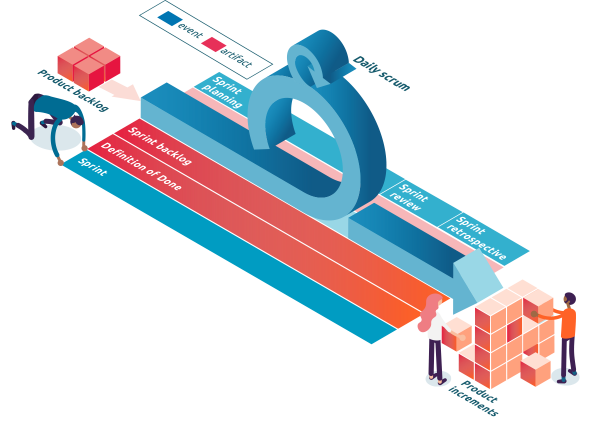Scrum
Scrum is a framework with which people address and solve complex problems in an adaptive manner, while delivering the highest value products in a rewarding and creative way. According to Schwaber and Sutherland, the authors of the Scrum guide [Scrum 2017], Scrum is:
- lightweight
- simple to understand
- difficult to master.

Scrum is a framework that creates value for the client in an Agile way. Scrum is not a process or technique for developing software products; it is a framework within which you can apply various processes and techniques.
The Scrum framework is built upon Scrum teams and their corresponding roles, events and products. Scrum assumes that knowledge arises from experience and taking decisions based on what is known. The team size could vary from three to nine people, excluding the Scrum master and the product owner. Scrum uses an iterative, incremental approach to optimize transparency and control risks.
The Scrum framework consists of roles, events and artifacts.
Roles
The Scrum team consists of a product owner, a Scrum master, and the development team. The term "development team" causes a lot of confusion because the team is not just responsible for development but for all activities necessary to deliver business value. Therefore, we prefer to refer to "team" or "Scrum team". Scrum teams are self-organizing and cross-functional. Self-organizing teams make their own choices when deciding on the best way to implement their work, instead of being instructed by someone outside the team.
Events
Scrum makes use of prescribed events to give the team structure and regularity, and to ensure that the sprint runs smoothly. Scrum makes use of timeboxes, so that every occurrence is bound by a maximum duration, and the most important matters (e.g. highest business value, highest risks, most refined) are dealt with first. When the timebox has expired, the most important matters have been covered, and insight gives a clear indication of what is still necessary. This ensures that the proper amount of time is spent on planning without loss of value ("waste") in the planning process. The events have been specifically designed to enable transparency and to create a fixed rhythm for the team. Not implementing one of these events results in a decline of effectiveness and transparency. Scrum supports the events: sprint, sprint planning, daily Scrum, sprint review and sprint retrospective.
Many teams see a backlog refinement as a useful addition to the Scrum events.
When multiple teams have to work together, they may implement a scrum-of-scrums where a representing member of each team gathers to align between teams.
Artifacts
Scrum works with the following artifacts: product backlog, sprint backlog, and products ("increment"). In addition, Scrum works most effectively when a "Definition of Done" has also been formulated. Although this is not mentioned in the Scrum guide, a Definition of Ready (both Business Ready and Sprint Ready) and a Definition of Shippable are also used by Scrum teams. Burndown charts are often used by the teams for transparency regarding progress.